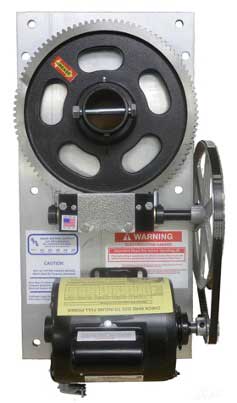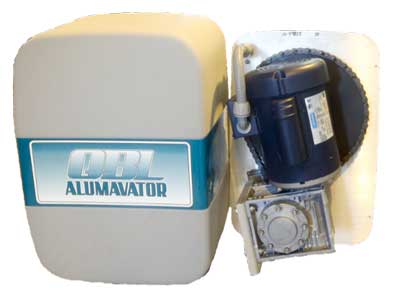A noisy flat plate drive can create unbearable, high-pitched squeals in older boat lifts. The sound can be so bad, in fact, that boaters are embarrassed to take early morning fishing trips. The squeals can wake up the entire neighborhood!
The YouTube video below shows a mild case of a flat plate screeching (sound on).
Now imagine a severe case… Nobody wants to live near that boat lift!
IMM Quality Boat Lifts stopped selling boat lifts with the flat plate drive decades ago. However, there are still older boat lifts in operation that feature flat plate drivers. Some manufacturers continue using flat plate drives.
Below, we’ll explain how to eliminate the noise.
Insufficient Repairs
Inexperienced service technicians often will grease up the boat lift. As a boat lift owner, your hope is that they find every grease fitting. Technicians often overlook a port outside of the back plate. Even after a thorough lubrication, the noise can return a few short days later.

Here’s why. The flat plate uses an open worm gear. Whatever grease is applied simply squeezes out over the next couple of uses. All of that grease has only made a mess inside your cover without providing lubrication for the gearing. By comparison, modern drive systems use enclosed worm gearboxes. That allows the worm gearing to turn through a grease reservoir, which provides continuous lubrication.
Insufficient lubrication, however, is only one part of the problem that’s causing the terrible noise. The real problem is the flat plate’s inherently flawed design. Over time, the shaft can pull the toothed sprocket and worm gear screw out of alignment. This misalignment causes chatter and vibration (the noise) as the shaft turns through the brass bushings alongside the worm gear screw.
Steps to Fix Noisy Flat Plate Drive
Most boaters and DIYers can fix a noisy flat plate drive by themselves. Follow these steps:
- Take your boat off the boat lift. This decreases tension on the gearing.
- Turn off power to the boat lift. This is a wise safety precaution.
- Make sure the left shaft collar is aligned with the end of shaft. When properly aligned, make sure the Allen key set screw is tight.
- Lightly tap on the left side of the shaft and shaft collar until it touches the brass bushing. In the picture above, you would be moving the shaft to the right. The shaft turns through this. The brass bushing is supported by the metal blocks and is barely visible in the photo. There should now be a gap between the right-side shaft collar and its brass bushing.
- Loosen the set screw on the right-side shaft collar. Move it over (to the left) until it touches its brass bushing.
- Re-tighten the set screw to keep the shaft collar in place.
- You now need to re-align the belt pulleys. Loosen the set screw on the upper pulley, moving it to align vertically with the lower pulley. Re-tighten the set screw on the pulley.
- Re-grease the open worm gear as best you can.
After following these steps, your flat plate drive should now be relatively quiet.

A Second Concern with Flat Plat Drives
In addition to noise, another complaint about the flat plate drive is the belt. Boaters often leave with no problems or issues in the morning. When they return in the afternoon, though, the lift might be unable to pick up the boat. That’s because the belt is slipping.
Here’s why.
Belts harden and contract in cooler temperatures, which is usually in the morning. Belts soften and expand as the day gets warmer in the afternoon.
Another fundamental design flaw of flat plate drives is that belts do not have an auto-tensioning system like in your car. That means if you adjust the belt to the correct tension during a cool morning, it will slip during a warm afternoon. If you adjust the belt to the correct tension for a warm day, it will become over-tight during a cool morning. This contracting and expanding can cause cracks and tears in the belt.
A Better Alternative
Flat plate drives certainly have their downsides, so why not invest in something better?
The experienced engineers at IMM Quality Boat Lifts designed the Alumavator to be superior to the flat plate drive in every way. Instead of an open worm gear, the Alumavator has a sealed gearbox. That keeps out dirt and maintains continuous lubrication. The Alumavator replaces the belt, which is prone to slippage and breaking, with a chain that dramatically improves durability.
The U.S. Army uses chain drives in their tanks and tracked vehicles. Caterpillar and John Deere also use chain drives in their heavy-duty earth-moving vehicles. There is a good reason. Chain drives have legendary durability and reliability.
Speed is another reason to make the switch. Flat plate drives are incredibly slow, while the Alumavator is much faster. In fact, the Alumavator has a high-speed version that is twice as fast as the standard version.

The Superior Choice
Speed. Durability. Performance.
The Alumavator is a superby engineered, gear-driven boat lift that sets the industry standard for a shafted beam boat lift. It’s one of three popular vertical boat lifts designed, engineered and manufactured by IMM Quality Boat Lifts:
Are you looking for a better boat lift? Complete our CONTACT FORM or REQUEST A QUOTE and we’ll give you a call!
Frequently Asked Questions (FAQs) About Fixing Noisy Flat Plate Drive
The noise often stems from the flat plate drive's design, leading to misalignment and friction that generates a loud squeal, particularly in older models.
Addressing the noise involves realigning shaft collars, adjusting belt pulleys, and re-greasing the open worm gear. These steps can significantly reduce the noise.
The open worm gear design causes grease to squeeze out quickly, failing to provide long-term lubrication, which can lead to persistent noise issues.
Temperature changes cause belts to harden, contract, or expand, affecting tension and potentially leading to slippage or damage.
The Alumavator, with its sealed gearbox and chain drive, offers a more reliable, durable, and faster solution than traditional flat plate drives.

